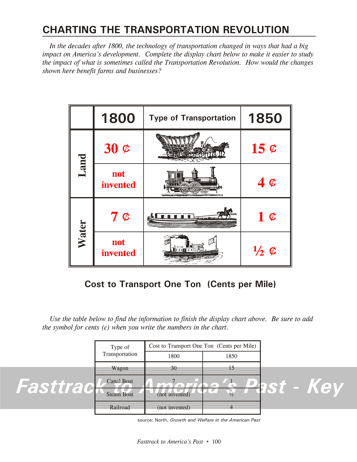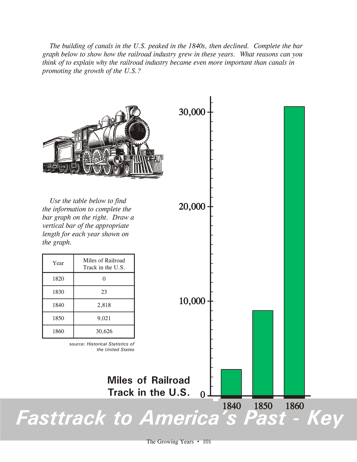| Fasttrack
to America's Past Teacher Key |
|
| Fasttrack
to America's Past Teacher Key |
|
 Page 100  Page 101 |
Pages 100
& 101 - Charting the Transportation Revolution Making the chart, page 100 Students can use a regular #2 pencil to complete this chart. It's a good idea to make sure students know what each picture in the chart represents. Remind students to add the symbol for cents. You might mention to students that the typical pay for a man's labor for a day ranged from 50 cents to about a dollar at that time. What the chart shows, page 100 This chart shows the incredible drop in the
cost of transportation
during the Growing Years. The Transportation Revolution made
settlement
of the western areas economically attractive, because goods could be
shipped
long distances and still bring a profit. Making the chart, page 101 Students will need just one color pencil for this bar graph. Green is a good choice. Notice that the table shows more information than is needed to complete the chart. The first bar is for the year 1840.What the chart shows, page 101 This chart shows the rapid spread of railroad lines in the U.S. during the decades from 1840 to 1860. Students should understand that this remarkable growth was driven mainly by people seeking profits in the transportation business. It required enormous investment of money. Railroads were the first really big businesses in the U.S., and remained as one of the dominant forces in the American economy right up to World War Two. Background for the chart question, page 100 The chart shows a very large drop in the cost of transportation during the Growing Years. Farms could ship their harvests to market and still make a profit. Farms could be located where land was cheap, and produce larger quantities for sale in distant cities. They could concentrate on one or two profitable cash crops, instead of trying to grow or produce everything the farm family would need. Low transportation costs also helped businesses. They could sell and ship their products over a much wider area. This allowed them to expand their output, which also tends to lower costs and prices. Background
for the chart
question, page 101 Railroads became even
more important
than canals in the growth of the U.S. for several reasons. They
move
products faster, and can go wherever tracks can be laid.
|
|
Copyright Notice
Copyright 2018 by David Burns. All rights reserved. Illustrations and reading selections appearing in this work are taken from sources in the public domain and from private collections used by permission. Sources include: the Dover Pictorial Archive, the Library of Congress, The National Archives, The Hart Publishing Co., Corel Corporation and its licensors, Nova Development Corporation and its licensors, and others. Maps were created or adapted by the author using reference maps from the United States Geological Survey and Cartesia Software. Please see the home page for this title for more information. |